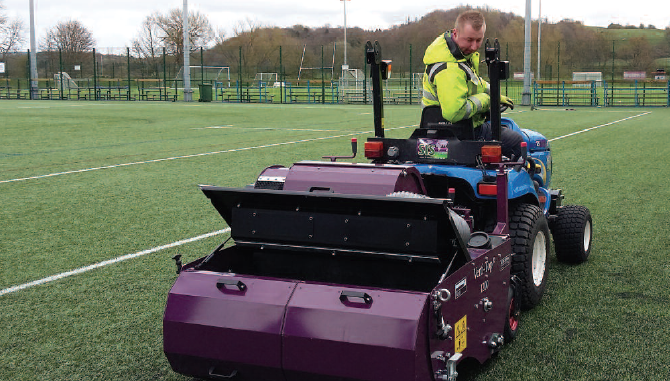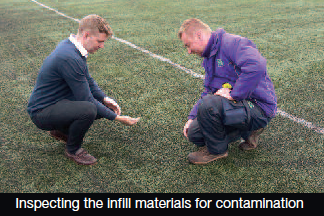
It makes little sense when you think of the investment that goes into providing the facility and the benefits a good pitch bring. Yet, time after time, a surface is allowed to deteriorate because there is a misconception that it is maintenance free. So why do you need to maintain your pitch?
Hockey
These days a well built, and installed, sand dressed hockey surface looks fabulous when new. No sand is visible just a great playing top. But it is what you don’t see that needs constant attention to keep it this way. Firstly, the sand infill can become contaminated with air blown particles such as sap from trees, pollution in the atmosphere, or from dirt brought on in footwear and, if left for too long, can be washed into the playing surface. If the pitch is not regularly brushed this pollution can quickly fester and form a crust that impacts drainage.
Brushing also helps collect debris from the surface top, such as fluff, tape, dried mud, but also helps stop the fibre from flattening. In certain areas a chemical treatment to deal with bacteria may be needed, but always seek advice from the surface provider first. In heavily used areas it may be necessary to top up sand and a twice yearly visit from an external, specialist maintenance company is strongly recommended.
Rugby/Football

When first laid the surface should have 20mm fibre free above the rubber infill. As the pitch is used actions such as running, sliding, ball bounce and body impact can dislodge the rubber. It is important therefore to brush the pitch regularly to regulate the infill levels. In addition, it is of the utmost importance to keep the fibre upright. This is best achieved through slow brushing of the surface and regular decompaction of the infill.
As with hockey the removal of surface debris, possible top up of infill material in high wear areas and a twice yearly specialist maintenance visit are essential to keeping your pitch in perfect condition.
So why doesn’t this happen?
Quite simply the enthusiasm of having a new pitch, working with new maintenance equipment and the pull of other more exciting grounds work sees attention to a pitch drop off after the first couple of years. The reliance on the twice yearly specialist maintenance visits provides a false belief that the pitch is being looked after correctly. And so surface providers strongly recommend that a maintenance log is kept up to date and regularly checked by pitch owners. In this way you can protect your investment and ensure it lasts longer and plays better.
A final tip is to brush your pitch at least 4 hours for every 40 hours of use. This should be done slowly, even when the temptation to open up the throttle on the equipment is great. Slow and sure, regular and consistent; these are the key words to remember.
Enjoy This Post?
Sign up for regular updates direct to your inbox
